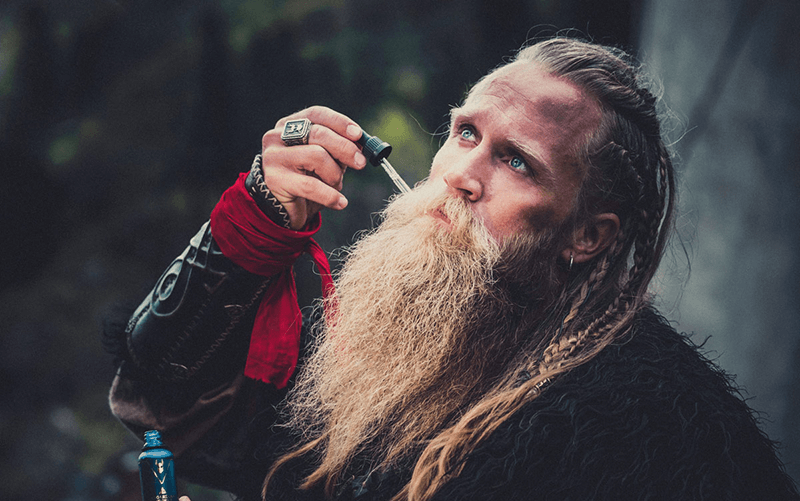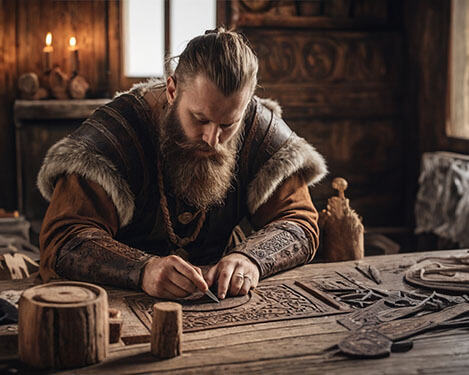The word Viking is familiar to everybody. The image it conjures is one of a fierce-looking warrior ready to cause havoc with an ax and shield. Most of what people know about Vikings comes from TV and movies, but the reality of their existence was a bit different. Master explorers and prolific traders, the Vikings left lasting impressions on every culture they came in contact with.
Viking ancestry can still be traced back to modern day people outside of Scandinavia. Genetic studies run by BritainsDNA show Yorkshire and North England as the most prominent areas with direct descendants of Vikings. The study also shows that 29.2% and 25.2% of the male population from Shetland and Orkney Islands are genetically connected to the Vikings. It is believed that in Britain alone, there were around 25,000 Danish Viking settlers during the Viking Age.
In recent years, Viking culture has seen a rise in popularity. The modern day Viking is defined not by his ancestry, religion, or place of birth, but rather by the things he believes in. A modern Viking is part of the future but keeps the values of the older times.
The modern day Viking community believes in bravery, honour, loyalty, discipline, and honesty. They embrace the viking aesthetics and the virtues of the Viking Age. Do you have the heart of a warrior? Are you a modern day Viking?
The History of Viking Nationality
Vikings are traditionally associated with Scandinavia, meaning modern day Denmark, Norway and Sweden. The word Viking has its origins in old Norse. The word víkingr was used to describe explorers, people who went on sea expeditions to foreign lands. Also, the word víkingr was not associated with a particular ethnicity or specifically bound to raiding activities. Vikings are historically descended from areas outside of Scandinavia, such as modern day Finland and Estonia.
The Vikings of the Viking age (750 - 1100AD) were organised in small groups that interacted mainly through trade and generally tended to feud amongst themselves. They were famed for the raids, but also as traders and mercenaries. During this period, Viking explorers could be found in all parts of northern Europe. Records of Viking trade were found as far as Baghdad.
The Viking Age begins with recorded raids on monasteries located on the British coastline. Spurred on by their success, raiding increased in frequency and extended to continental Europe.
Later, Vikings started creating settlements in the British Isles and gained control of islands like Shetland, Orkney, and Hebrides. Around 871, much of England fell to Viking conquest and the area north of Wessex became known as Danelaw. English armies took back control of the territory around 952.
On the European mainland, one of the most famous Viking legacies can be found in France, where the region of Normandy is translated as ‘land of the Northmen’. Norwegian Vikings colonised Iceland and Greenland, and may have been the first Europeans to discover North America. The Viking Age came to an end with the spread of Christianity and the birth of Norway as a Nation.

What defines a real Viking
Although modern-day media often paints Vikings as brutish barbarians, raiders, and pillagers, their way of life was ruled by many values and virtues which are relatable to us in the present day. The harsh Scandinavian environment had birthed tough people who were resilient and resourceful.
Bravery
A keen knowledge of sea travel was the incentive that sent Vikings to explore new lands. The Vikings were indeed violent people, but they were not alone. The world around them was also a violent place. Vikings needed to be brave in order to face the long voyages into uncharted waters, to confront unknown enemies, or to defend their homes and loved ones. Bravery defines a true warrior and a real Viking.
Ambition
Viking ambition is reflected in their history - their relentless need for expansion, their search for a better life for them and their loved ones. They continuously expanded their raiding expeditions, their trading routes, and their explorations. The fact that their expeditions led them as far as modern day Canada and Iraq is an uncontestable testimony to Viking ambition.
Loyalty
Contrary to popular belief, Vikings were not traditionally organized as a single group, but rather as small communities led by a chieftain. A Viking warrior would have been loyal to his chieftain and his fighting brothers. Traveling, fighting, and working together developed a strong feeling of community and created strong bonds of loyalty.
Honour
Personal honour was essential to a Viking’s standing in society. A warrior would maintain his honour by showing courage, loyalty, generosity, and wisdom. A Viking’s reputation rested on his honour and all he did was to secure a lasting legacy. Viking society was centered around family, lineage, and reputation, and a warrior’s life was bound by duty and honour.
Cleverness
Intelligence and knowledge will always be associated with Vikings. They were known for their superior knowledge of marine navigation, clever tactics used in battle, or their ability to adapt to and assimilate local cultures.
Cleverness was seen as an important personal attribute. The cultivation and nurturing of knowledge and advancement was one of the fundamental reasons for the Vikings’ success as traders and conquerors.

The Myth and Reality of the Viking Sub-Culture
The image of the Viking warrior has changed slightly over the years, with growing interest in the Viking sub-culture, and popular shows and movies having accurate documentation behind their production.
Still, there are many misconceptions out there about Vikings and their society and culture.
- The most popular myth is without a doubt the use of horned helmets. There are no historical records of helmets decorated with horns. In fact, this particular Viking image was probably perpetuated by the production of Richard Wagner’s opera The Ring of the Nibelung.
- Another myth is related to the existence of a Viking state. Although the Scandinavian peoples and those of the surrounding areas shared a common language, religion, and cultural traits, they were never united under a single ruler. In fact, they were organized in small communities with local governance under a chieftain. These different groups of Vikings usually traded amongst themselves or fought for territory and goods.
- Most people think of Vikings as bloodthirsty barbarians. This image has been perpetuated throughout the ages because their raiding and conquests were usually written from the perspective of the people they attacked. A factual explanation is that raids were chosen strategically. They chose monasteries because they often held riches and goods and because they were undefended. Another aspect of their conquest campaigns was the expansion of their trade routes, which sometimes resulted in the development of settlements.
- Another interesting misconception is that all Vikings were given a flaming ship funeral. This is one of the things associated with Viking culture, but the truth is that ships were expensive so this particular ritual was not a common practice. Most of the time bodies were buried or cremated in funeral pyres.

What is the Viking Lifestyle?
When most people think of the Viking lifestyle, the first thing that comes to mind is war, a life of battle and bloodshed. But the truth is that the raiding activities were part of seasonal campaigns and were organized affairs.
Vikings spent most of their time with common activities like farming, fishing, and trading. They would also unwind with friends and family, play games, or enjoy some music. Apart from the violent aspect of their culture, most of their daily lives were not so dissimilar to our own.
Most Scandinavians actually lived a peaceful life growing crops, raising livestock, or being preoccupied with other trades like blacksmithing, wood crafting, boat building, leather-working, or fishing.
The Viking style of clothing was diverse. They would wear clothes made from animal skins or wool. Sometimes, the clothes were intricately weaved with patterns and dyes. One of the most defining traits of Viking fashion was the use of jewelry as a decoration for both men and women.
Viking homes were utilitarian and designed to endure the temperamental Scandinavic climate. Longhouses, as they are named, were wooden structures with a central fireplace that was used for cooking and heat. The fireplace was usually surrounded by benches which provided seating for socializing and sleeping. Livestock and goods were also kept in the longhouse.
A normal Viking diet was rather diverse, with easy access to fish and meat on a regular basis. They would also make bread and forage for fruits and nuts. The balanced diet might also be a good explanation for the height difference between Scandinavians and the rest of Europe at that time in history. The estimated average height was about 5'5'' ft for men and 5'1'' ft for women.
Just like modern-day people, Vikings had their own selection of fun activities. They enjoyed sports like racing, skiing, and sparring. They even had their own version of a strategy board game similar to chess. They also filled their time with cultural activities like music, poetry, and storytelling.
Is It Possible To Be A Modern-Day Viking?
The concept of a Modern-Day Viking is associated with a philosophy of life, a lifestyle centered around the old values of the Vikings: honour, bravery, honesty, loyalty, perseverance, and discipline.
Having a good moral compass and living a life centered around self-improvement is a guaranteed path to happiness that can boost some personal aspects, such as confidence, relationships and work capacity.
A modern day Viking is brave in the face of adversity, faces challenges head-on, is generous and caring with his loved ones, and always lives by his code of honor. A modern Viking is also concerned with self-improvement, and he takes care of his mind and body. Just like the historical characters, a modern Viking is not defined by race, religion, or nationality but by his reputation.
Anyone can become a modern-day Viking. You don’t have to be a warrior in real life, but you have to be one in your heart. It’s all about your mindset and the way you look at things. Instead of obstacles, you see challenges and gains. You chose to live an honorable life, demand respect from others and give it in return.

What Matters To A Modern-Day Viking
A modern Viking is mainly concerned with self-improvement, finding new ways to challenge himself, facing life with a sense of adventure, and never turning his back on injustice. This warrior mindset can be applied in everyday life as a personal philosophy and a way to achieve happiness and success. Here are some things that matter to a modern-day Viking:
- Having a healthy body
- just like their historical counterparts, modern Vikings are concerned about their health. A balanced diet, fresh air, and exercise are a winning combination for leading a healthy life, improving confidence, and being happy.
- Having a healthy mind - having goals, facing your fears, and being disciplined will allow you to find a different approach to events in your life, gain confidence, and be better at your job.
- Belonging to a brotherhood - loyalty is a defining trait for a Viking. Belonging to a community and surrounding yourself with people you love can drastically change your quality of life. Humans are social beings and having good relationships is one of the key elements that lead to a happy and fulfilling life.
- Having a defined identity - the way you feel is also reflected in the way you look. Vikings took great pride in the way they looked. Contrary to popular belief, they took care of their external appearance and were renowned for their excellent hygiene habits. They used combs and accessories for their hair and beards, and they used adornments such as jewelry.

Products Modern Vikings Use
Just like their historical counterparts, modern day Vikings have a disciplined grooming routine. Looking your best is an easy way to boost your confidence and change your mindset.
Getting a nice haircut and taking good care of your beard are part of an efficient self-care routine. Having a good shaving kit and the right grooming products can go a long way to creating a look that defines your style.
Having a beard is an integral part of the statement Viking look. It changes your image, makes your features more masculine, and gives you an air of maturity that demands instant respect. Taking care of your Viking beard is essential. As a modern Viking, you have dedicated products for cleaning and hydrating, as well as combs and brushes for daily styling.
To complete the Viking look, pick an outfit with masculine lines, some color, patterns, and don’t forget to accessorize. Vikings used to wear jewelry like rings, necklaces, and bracelets as a style preference and sometimes as a way to show off their standing in society.
Being a modern day Viking gives you the opportunity to be a better version of yourself, allows you the confidence to express your unique style, and changes the way you live your life.
Embrace the lifestyle of a modern day Viking
Check out The Beard Struggle’s shop and find the tools you need to make your beard the envy of your bearded brethren.
Sources:
- https://www.yorkshirepost.co.uk/news/its-official-dna-tests-show-yorkshire-people-really-are-different-breed-1879236
- https://www.cambridge.org/core/journals/antiquity/article/what-caused-the-viking-age/9AAD157E488AF39555B64D3529944D43
- https://www.jstor.org/stable/20836943
- https://www.brepolsonline.net/doi/abs/10.1484/J.VMS.5.121523
- https://www.britannica.com/topic/Der-Ring-des-Nibelungen



















